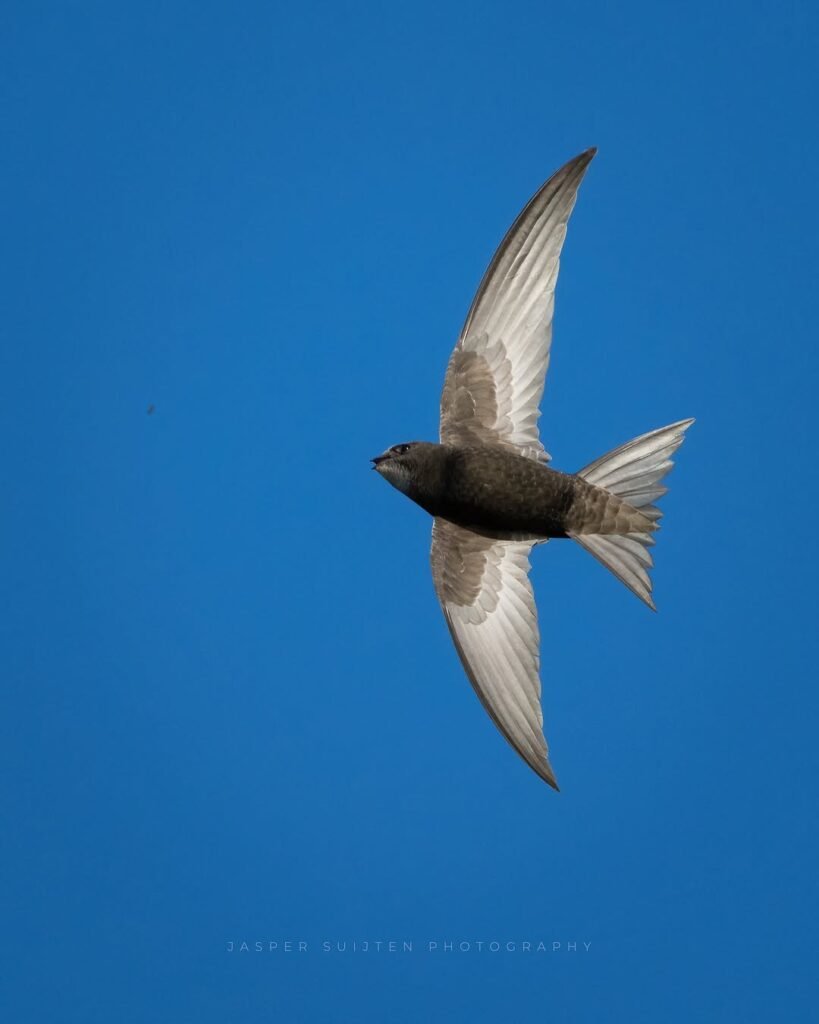Each British summer, as the skies brighten and days grow longer, an unmistakable call echoes above rooftops and church steeples. The swift, with its curved wings, forked tail, and high-pitched scream, returns from Africa for a brief few months of energetic breeding and elegant flight. These birds arrive in late April or early May, remaining until August before embarking on their long return across continents. This remarkable migration, covering some 14,000 miles each year, marks the swift as one of Britain’s most remarkable – yet currently threatened – migrant birds.
The Life and Flight of a Swift
Swifts are masters of the air. They sleep, feed, bathe, and even mate while flying, only landing to nest and raise young. Their top speeds reach nearly 70mph in level flight, making them Britain’s fastest bird in the air, aside from the peregrine falcon in a dive. Most swifts appear a sooty brown but look black against the sky, with sickle-shaped wings and a dash through the air that draws attention even from casual observers.
Despite their prowess, swifts struggle on land. Their legs are short and weak, adapted only for clinging to vertical surfaces. Nesting almost exclusively under the eaves of old buildings, they depend on these cavities for breeding, returning to the same spot each year. Historically, they also nested in trees and cliffs, but urbanisation has shifted their breeding close to people.
Marvels of Migration
The migration of the swift is among the greatest in the animal kingdom. Swifts travel from sub-Saharan Africa to the UK, making stopovers in places like Portugal and France along the way. The full journey can extend up to 22,000km annually. On a typical day, a swift may cover nearly 500 miles searching for flying insects, their sole food source. Some experts estimate that a single swift can gather 100,000 insects in just one day when feeding chicks.
Swifts spend most of their lives airborne and have been recorded staying aloft, without landing, for as long as two to three years outside the breeding season. Their migration is relentless and precise, with most arriving in the UK together and departing swiftly (no pun intended) once the chicks have fledged.
Conservation: A Red Warning
The sound and sight of swifts once defined British summers. Today, these birds face severe decline. In 2020, swifts were added to the UK’s Red List of Birds of Conservation Concern, which highlights species in urgent need of help. Their numbers have fallen by at least 66% from 1995 to 2022, with some estimates as high as 60% to 66% in recent decades. For every ten swifts seen in 1995, only three now grace our summer skies.
Experts attribute this crisis to several factors. The loss of nesting sites, as old buildings are renovated or demolished and modern designs seal up eaves and gaps, is central. Swifts need access to small cavities to breed, and these are rapidly vanishing. Food shortage adds another challenge. Insect populations, vital to swifts, have decreased due to changing agricultural practices and the widespread use of pesticides.
Climate change further complicates matters. Increased weather extremes and shifting insect emergence times can disrupt migration and breeding cycles, affecting survival and success rates.
Campaigns for Change
This year, the call to save the swift is louder than ever. Swift Awareness Week, running from late June to early July 2025, involves over a hundred events across the UK. From walks and talks to nest box workshops, enthusiasts and local groups hope to inspire a broader public and political response.
A key focus is the push for “swift bricks” in new buildings. These bricks, designed for cavity-nesting birds, could offer safe nesting options as old buildings are lost. Parliament is set to debate proposals to require swift bricks in all new-builds above five metres. Supporters say this could halt, and even reverse, the decline of the species if action is taken soon.
Community groups and individuals are also making a difference by installing nest boxes or “bricks” in private homes, schools, and churches. Some villages have seen their swift populations multiply thanks to local projects and the efforts of swift champions across the country.
Spotlight on Urban Wildlife
Swifts bring excitement, drama, and beauty to Britain’s urban landscapes. Unlike most summer visitors, they thrive in the heart of cities and towns, soaring over terraced houses, cathedrals, and high streets. Their presence is a direct link to the health of our urban wildlife and green spaces, where biodiversity is under pressure.
Swifts mate for life and show strong fidelity to their nest sites, returning each summer after thousands of miles in the sky. Their bonds and social behaviour – often seen in fast-flying “screaming parties” at dusk – captivate many who take notice.
British Experts and Conservation Voices
The campaign to save the swift has attracted notable supporters. Ornithologists, naturalists, and conservationists have spoken out about the urgent need to protect both the species and its nesting sites. Jane Goodall, famed conservationist, has been a vocal advocate, using her platform to promote swift protection and wider awareness, while the RSPB and local wildlife trusts are leading national campaigns. Keith Betton, a Hampshire ornithologist with more than fifty years’ experience, notes that “climate changes and diminishing insect populations” are among today’s main threats to swift survival.
Conclusion
The story of the swift resonates widely because it represents both nature’s wonder and fragility. Their speed, stamina, and mysterious, almost ghost-like lifestyle inspire awe. At the same time, their sharp decline reflects the risks facing so much of the UK’s urban wildlife.
Efforts to halt the swift’s decline now stand at a critical junction, with Swift Awareness Week, parliamentary debates, and passionate local advocates all pushing for change. The outcome will shape Britain’s summer skies and much else about our changing environment. Swifts, the “arrows of summer”, could yet find new hope with support from citizens and leaders alike.
To read more click here

